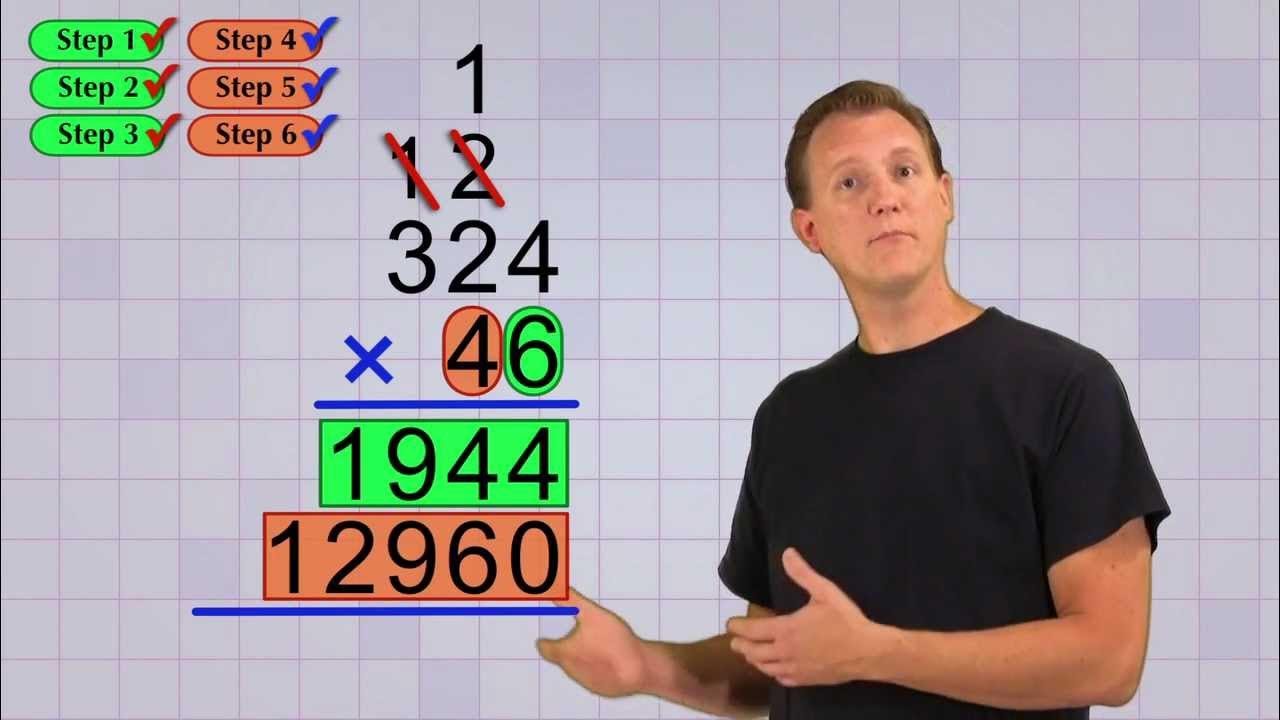Introduction to multiplying decimals | Decimals | Pre-Algebra | Khan Academy
Summary
TLDRThe video script offers a detailed explanation of multiplying 9 by 0.6. It begins by encouraging viewers to calculate the result themselves, then provides a hint that 0.6 is equivalent to 6 divided by 10. The script proceeds to demonstrate the multiplication by first calculating 9 times 6, yielding 54, and then dividing by 10 to account for the decimal, resulting in 5.4. The presenter highlights the pattern of decimal places and invites viewers to consider whether the number of digits after the decimal in the factors determines the number of digits after the decimal in the product.
Takeaways
- 🔢 The script begins with a multiplication problem: 9 times 0.6.
- 📝 It suggests rewriting 0.6 as 6 divided by 10 to simplify the calculation.
- 📚 The concept of moving the decimal place is explained as dividing by 10.
- 🤔 The viewer is encouraged to pause and attempt the problem independently.
- 📉 The hint provided is that 6.0 divided by 10 equals 0.6, moving the decimal one place to the left.
- 📈 The multiplication strategy involves first calculating 9 times 6, then dividing by 10.
- 🎯 The result of 9 times 6 is 54, which is then divided by 10 to get the final answer.
- 📌 The division by 10 is illustrated by adding a decimal and moving it one place to the left.
- 📉 The final answer for 9 times 0.6 is given as 5.4.
- 🧩 The script highlights a pattern where the number of digits to the right of the decimal in the factors determines the number of digits to the right of the decimal in the product.
- 💭 It invites the viewer to consider whether this pattern is a general principle for multiplication involving decimals.
Q & A
What is the initial multiplication problem presented in the script?
-The initial multiplication problem presented in the script is to calculate 9 times 0.6.
What is the hint given to help understand the multiplication of 9 by 0.6?
-The hint given is that 0.6 is equivalent to 6 divided by 10, which can be visualized by moving the decimal point one place to the left.
Why is it suggested to pause the video and try to figure out the multiplication on one's own?
-It is suggested to pause the video to encourage active learning and personal problem-solving, allowing viewers to engage with the material more deeply.
What is the alternative method to calculate 9 times 0.6 presented in the script?
-The alternative method is to first calculate 9 times 6, which equals 54, and then divide the result by 10 to account for the decimal in 0.6.
How does dividing by 10 affect the decimal place in a number?
-Dividing by 10 shifts the decimal place one position to the left, effectively reducing the number by a factor of 10.
What is the result of the multiplication 9 times 6?
-The result of the multiplication 9 times 6 is 54.
What is the final result of the multiplication 9 times 0.6 after dividing by 10?
-The final result of the multiplication 9 times 0.6, after dividing by 10, is 5.4.
What pattern is observed between the numbers 54 and 5.4 in the context of this multiplication?
-The pattern observed is that when multiplying by a decimal, the number of digits to the right of the decimal in the multiplier corresponds to the number of digits to the right of the decimal in the product after division.
What does the script suggest as a general principle for multiplying whole numbers by decimals?
-The script suggests that you can multiply the whole numbers first, ignoring the decimal, and then adjust the product by dividing by 10 for each digit to the right of the decimal in the original multiplier.
How does the script use the concept of decimal notation to explain the multiplication process?
-The script uses the concept of decimal notation to explain that each place value to the right of the decimal represents 1/10 of the place to its left, which is why dividing by 10 moves the decimal one place to the left.
What is the significance of the pattern discussed in the script for understanding multiplication with decimals?
-The significance of the pattern is that it provides a visual and conceptual framework for understanding how the position of the decimal point affects the product in multiplication, which can be a helpful tool for problem-solving with decimals.
Outlines

このセクションは有料ユーザー限定です。 アクセスするには、アップグレードをお願いします。
今すぐアップグレードMindmap

このセクションは有料ユーザー限定です。 アクセスするには、アップグレードをお願いします。
今すぐアップグレードKeywords

このセクションは有料ユーザー限定です。 アクセスするには、アップグレードをお願いします。
今すぐアップグレードHighlights

このセクションは有料ユーザー限定です。 アクセスするには、アップグレードをお願いします。
今すぐアップグレードTranscripts

このセクションは有料ユーザー限定です。 アクセスするには、アップグレードをお願いします。
今すぐアップグレード関連動画をさらに表示

Math Antics - Multi-Digit Multiplication Pt 2

Menghitung Inflasi dan Gross Domestic Product dalam Mata Kuliah Bisnis Internasional

Mean, Median, and Mode of Grouped Data & Frequency Distribution Tables Statistics

Equivalent Fractions - Review | Mathematics Grade 5 | Periwinkle

Unit 1 Lesson 1 Practice Problems IM® Algebra 2TM authored by Illustrative Mathematics®

Numerology For Number 9 | For Birthdates - 9, 18 & 27 | How Lucky are You?
5.0 / 5 (0 votes)
